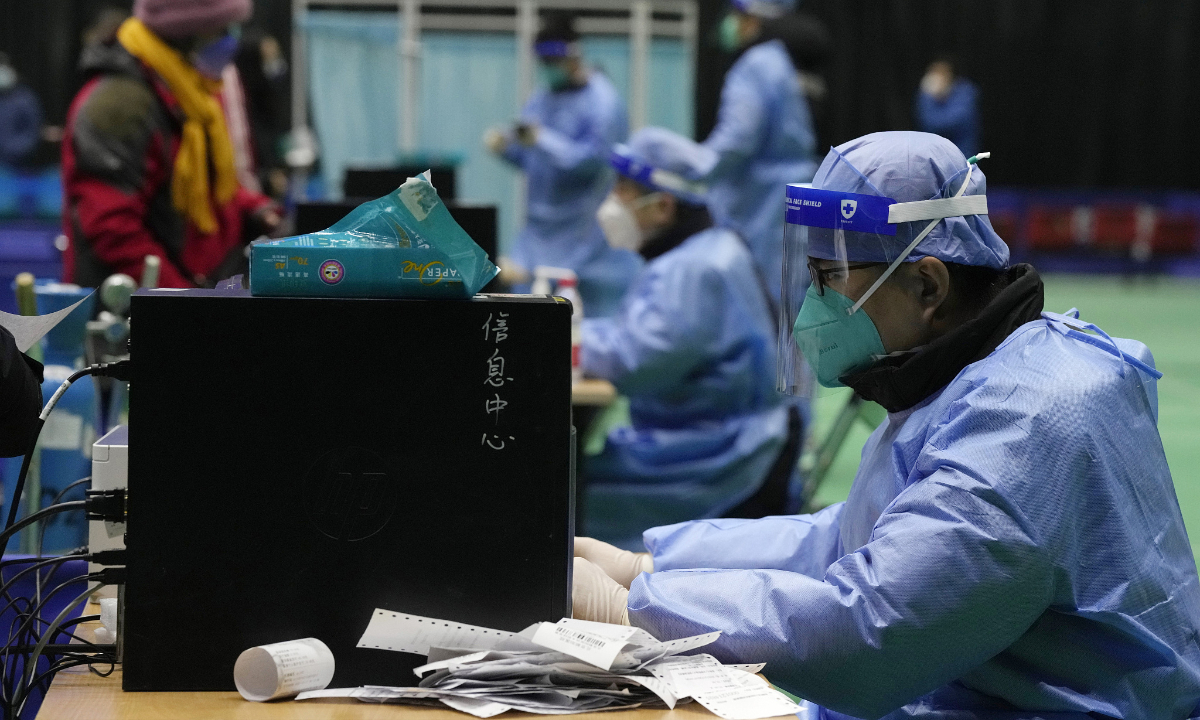Stress on Beijing hospitals expected to ‘gradually ease’ while other cities bracing for peak infection numbers

Medical workers attend to visitors at a fever clinic converted from a gymnasium in Beijing on December 17, 2022. Photo: VCG
ICUs in Beijing are still under stress as community transmission of Omicron has led to increasing severe cases ̶ most of whom are elderly ̶ in a short period of time, the Global Times has learned from experts.
However, as a whole, the stress on Beijing hospitals is gradually declining as local epidemic peak is approaching its climax, experts said, while other cities across the country are bracing for peak infection numbers
Posts went viral on Chinese social media platforms on Saturday claiming that some COVID-19 patients in Beijing and North China's Hebei Province have showed signs of white lungs in their CT scan results.
According to published studies, in some COVID-19 cases, the diffuse ground glass infiltration may give lungs the appearance of white lung.
Some posts claimed that the white lung phenomenon indicated that these cases were not infected with the Omicron variant but the original variant that was detected in Wuhan, triggering public concerns or even panic.
Beijing health authorities claimed late in November that the dominant virus during the current outbreak is BF.7. Experts reached by the Global Times on Saturday have tried to ease public concerns, clarifying that white lung is a normal symptom of severe and critical COVID-19 patients no matter what variants the patients are infected with.
Wang Guangfa, a respiratory expert from Peking University First Hospital, told the Global Times on Saturday that as the virus has spread to the communities in Beijing, more elderly people and those with underlying diseases have been infected so that the capital city had witnessed an increase in the absolute number of severe cases.
The overall rate of severe cases during outbreaks caused by Omicron is lower that of outbreaks during the early stage, but as Omicron spreads very fast, it can lead to a large number of cases in a short period of time, that is why people seem to have seen more reports of white lung cases, Wang explained.
As the number of cases climb, and many medical workers were infected, there have been reports of staff shortage in hospitals across the country, especially in major cities that are undergoing the infection peak.
In Beijing, the pressure in fever clinics has eased recently, but the pressure on the ICUs is still intensifying, according to Wang.
As the peak of this wave of epidemic in Beijing is approaching to an end, the staffing crunch is gradually easing, experts said, while other places in China are bracing for rising infection numbers.
The Global Times learned from a resident in Qinhuangdao, Hebei Province, surnamed Jiang whose father-in-law is hospitalized after being infected with COVID-19, that many doctors and nurses in the hospital have been infected.
On Friday, there were only two nurses on duty in the ward, as other staff were still recovering, Jiang said.
The authorities in South China's Hainan Province announced on Friday that the province is witnessing rapidly climbing cases and expected to encounter the epidemic peak along with the New Year and Spring Festival holidays.
In response, the Hainan authorities set up 22 county-level emergency medical services teams for 15 local counties. Each team consists of at least 18 members. A total of 432 medical institutes in the province have established fever clinics with a total of 806 consulting rooms.
The province has also repurposed local nucleic acid testing sites in local communities into fever consulting rooms so as to provide services and drugs to local residents more conveniently.
Officials in Qingdao, East China's Shandong Province, said Friday that the city has optimized it local triage system as cases spike ahead of an anticipated peak
Authorities in East China's Anhui Province also said on Friday that most places in the province are anticipated to see peak cases by the end of December which would last for about three days before the epidemic starts to decline.



